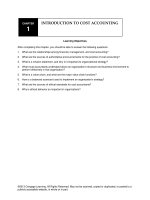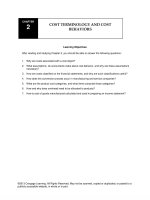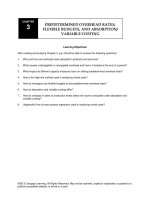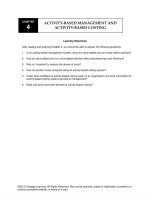Solution manual financial accounting 9th harrison ch10
Bạn đang xem bản rút gọn của tài liệu. Xem và tải ngay bản đầy đủ của tài liệu tại đây (1.96 MB, 88 trang )
Find more at www.downloadslide.com
Chapter 10
Stockholders’ Equity
Short Exercises
(5 min.) S 10-1
Corporation’s advantages:
Continuous life
Transferability of ownership
Limited liability of the stockholders
Ease of raising capital
Corporation’s disadvantages:
Double taxation of distributed profits
Government regulation
Separation of ownership and management
(5 min.) S 10-2
1. The stockholders hold ultimate power in a corporation.
2. The chairperson of the board of directors is usually the most
powerful person in a corporation. The title is also often CEO.
3. The president is in charge of day-to-day operations. The title is COO.
4. The chief financial officer is in charge of accounting and finance. The
title is CFO.
Chapter 10
Stockholders’ Equity
10-1
Find more at www.downloadslide.com
(5-10 min.) S 10-3
1. The common stockholders are the real owners of a corporation.
2. Preferred stockholders have priority over common stockholders in (1)
receipt of dividends and (2) receipt of assets if the corporation
liquidates.
3. Common stockholders benefit more from a successful corporation
because the preferred stockholders’ dividends are limited to a
specified amount. The common stockholders take more risk so their
potential for gains through an increase in the value of the company’s
stock is unlimited.
10-2
Financial Accounting 9/e Solutions Manual
Find more at www.downloadslide.com
(5-10 min.) S 10-4
TO:
Jessica Johnson and Claudia Stein
FROM:
Student Name
RE:
Steps in forming a corporation
The first step in organizing a corporation is to obtain a charter from the
state. The charter authorizes the corporation to issue a certain number
of shares of stock to the owners of the business, who are called
stockholders. The corporation will exist when the incorporators pay
fees, sign the charter, file documents with the state, and agree to a set of
bylaws to determine how the corporation is to be governed internally.
Later steps include the stockholders electing a board of directors who in
turn appoint officers to manage the corporation on a day-to-day basis.
These officers consist of the chairperson of the board (the chief
executive officer) and the president (the chief operating officer), who
lead the chief financial officer, who manages the day to day operations
of the controller (accounting officer) and treasurer (finance officer).
(5-10 min.) S 10-5
The $47,952,000 was paid-in capital. It was not a profit and therefore had
no effect on net income.
The par value of stock has no effect on total paid-in capital. Total paid-in
capital is the total amount that stockholders have invested in (paid into)
a corporation, including the par value of stock issued plus any
additional paid-in capital.
Chapter 10
Stockholders’ Equity
10-3
Find more at www.downloadslide.com
(10 min.) S 10-6
Millions
Hana Printer:
Cash…………………………………………….
Common Stock…………………………….
Additional Paid-in Capital………………..
17,827
27
17,800
Delightful Doughnuts:
Cash…………………………………………….
Common Stock…………………………….
298
298
(10 min.) S 10-7
Case A — Issue stock and buy the assets in separate transactions:
Journal
DATE
ACCOUNT TITLES AND EXPLANATION
DEBIT
Cash ...........................................................
Common Stock (17,000 × $25) ..........
Paid-in Capital in Excess of Par .......
Issued stock.
850,000
Building .....................................................
Equipment .................................................
Cash .....................................................
Purchased plant assets.
590,000
260,000
CREDIT
425,000
425,000
850,000
Case B — Issue stock to acquire the assets:
Building .....................................................
590,000
Equipment .................................................
260,000
Common Stock (17,000 × $25) ..........
Paid-in Capital in Excess of Par .......
Issued stock to acquire building and equipment.
The balances in all accounts are the same.
10-4
Financial Accounting 9/e Solutions Manual
425,000
425,000
Find more at www.downloadslide.com
(5-10 min.) S 10-8
Thousands
Stockholders’ equity:
Common stock, $.01 par, 800 thousand shares
issued……………………………………………...
$
8
Paid-in capital in excess of par…………………..
193
Retained earnings…………………………………..
643
Other stockholders’ equity………………………..
(27)
Total stockholders’ equity………………………...
$817
(10 min.) S 10-9
Amounts In Thousands
a.
b.
c.
Total revenues………………………………………..
$1,370
Total expenses………………………………………..
812
Net income………………………………….…………
$ 558
Accounts payable……………………………………
$ 460
Other current liabilities……………………………...
2,562
Long-term debt………………………………….……
23
Total liabilities………………………………………...
$3,045
Total liabilities (from Req. b)……………………….
$3,045
Total stockholders’ equity (from S 10-8)…………
817
Total assets……………………………………………
$3,862
d.
Net profit
ratio
Net income
Total revenues
$558
$1,370
Chapter 10
= .407
Stockholders’ Equity
10-5
Find more at www.downloadslide.com
(continued) S 10-9
e.
Asset
turnover
Total revenues
Total assets
$1,370
$3,862
= .35
Total assets
Total stockholders’ equity
$3,862
$817
= 4.72
Net income
Total stockholders’ equity
$558
$817
= .67
f.
Leverage
ratio
g.
Return on
equity
Prior year returns from the company and comparative data for
competitors would also be helpful to make decisions.
(5 min.) S 10-10
Journal
DATE
ACCOUNT TITLES AND EXPLANATION
Treasury Stock……………………………...
Cash……………………………………….
Cash…………………………………………..
Treasury Stock…………………………..
Paid-in Capital from Treasury Stock
Transactions………………………….
DEBIT
CREDIT
Millions
22
22
15
4
11
Overall, stockholders’ equity decreased by $7 million ($22 million paid
out minus $15 million received).
10-6
Financial Accounting 9/e Solutions Manual
Find more at www.downloadslide.com
(15-20 min.) S 10-11
Req. 1
MEMORANDUM
TO:
Karen Knox Exports, Inc., Board of Directors
FROM:
Student Name
RE:
How the purchase of treasury stock will make it more difficult
for outsiders to take over the company
Purchasing treasury stock decreases the amount of stock outstanding. If
Karen Knox Exports holds a sufficient quantity of company stock in the
treasury, outsiders, such as the Alberton investor group, may not be
able to acquire a controlling interest (50+ percent) of the outstanding
stock from the remaining stockholders. Because it takes cash to buy
treasury stock, the purchase decreases the size of the corporation.
Reducing the company’s cash position may make the company
sufficiently unattractive to cause the outside investors to abandon their
takeover plan.
Req. 2
Sales of treasury stock at prices above the purchase price increase
company assets because of the greater amount of assets coming in
from the sale than went out to buy the stock. Treasury stock
transactions do not affect liabilities, so the sale of treasury stock also
increases stockholders’ equity. These sales of treasury stock will not
affect net income because the company is dealing with its owners.
Transactions between the corporation and its owners cannot generate a
profit or a loss that is reported on the income statement.
Student responses may vary.
Chapter 10
Stockholders’ Equity
10-7
Find more at www.downloadslide.com
(10 min.) S 10-12
Journal
ACCOUNT TITLES AND EXPLANATION
DATE
2012
Dec. 15 Retained Earnings
($200,000 × .08) + (40,000 × $.15)………
Dividends Payable……………………
Declared a cash dividend.
2013
Jan. 4 Dividends Payable……………………….
Cash…………………………………….
Paid the cash dividend.
DEBIT
CREDIT
22,000
22,000
22,000
22,000
During 2012, Retained Earnings increased by $63,000 (net income of
$85,000 − dividends of $22,000).
(5-10 min.) S 10-13
1. $121,500 (90,000 shares × $1.35 per share)
2. Preferred: $121,500
Common: $428,500
3. Cumulative, because it is not specifically designated as
noncumulative.
4. Preferred: $364,500 ($121,500 × 3)
Common: $1,235,500 ($1,600,000 − $364,500)
10-8
Financial Accounting 9/e Solutions Manual
Find more at www.downloadslide.com
(5-10 min.) S 10-14
Req. 1
Journal
DATE
ACCOUNT TITLES AND EXPLANATION
DEBIT CREDIT
May 11 Retained Earnings (18,000 × .08 × $20)……….. 28,800
Common Stock (18,000 × .08 × $4)………....
5,760
Paid-in Capital in Excess of Par-Common...
23,040
Req. 2
No effect on total assets.
No effect on total liabilities.
No effect on total stockholders’ equity.
Chapter 10
Stockholders’ Equity
10-9
Find more at www.downloadslide.com
(10 min.) S 10-15
Total stockholders’ equity………………………………
Less:
$4,877,000
Preferred stock………………………………….
(450,000)
Preferred dividends in arrears
(35,000 × .01 × $12 x 3)…………………….
Common equity…………………………………………..
(12,600)
$4,414,400
Number of common shares outstanding
(67,000 − 1,400)………………………………………..
Book value per share of common stock……………..
10-10
Financial Accounting 9/e Solutions Manual
÷ 65,600
$
67.29
Find more at www.downloadslide.com
(5-10 min.) S 10-16
(a)
(b)
Rate of return on
total assets (ROA) =
Rate of return on
common
stockholders'
equity (ROE)
Profit margin x Asset turnover
=
ROA x Leverage ratio
Req. 1
The components of ROA are net profit margin and asset turnover. Net
profit margin (net income/net sales) is a measure of operational
effectiveness. It measures the percentage net profit generated for each
dollar of sales. Generally, companies that can differentiate a highly
desirable product can sell the product for more, generating a higher
profit.
Asset turnover (net sales/average total assets) is a measure of efficiency
in use the use of assets. Generally, companies that can cut costs by
reducing the amount invested in fixed assets and inventory without
sacrificing sales revenue are more efficient. Asset turnover measure
sales generated for each dollar of assets invested.
Req. 2
The leverage ratio (average total assets/average common stockholders’
equity) measures the impact of the use of borrowed capital on return on
equity. It magnifies the ROA to make ROE larger.
Req. 3
If ROA is positive, leverage makes ROE more positive.
If ROA is
negative, leverage makes ROE more negative.
Chapter 10
Stockholders’ Equity
10-11
Find more at www.downloadslide.com
(10-15 min.) S 10-17
Req. 1
Profit
=
margin
Net income
Revenues
Asset
turnover =
Revenues
Average total
assets
=
ROA
.012%
=
.0154
¥7,632
¥7,632
= (¥9,523 + ¥10,632)/2
= ¥10,078
Leverage
Avg. total assets
=
ratio
=
Avg. com.
stkholders’ equity
Profit
Margin
.0154
¥118
¥7,632
¥10,078
(¥2,884 + ¥3,218)/2
¥10,078
= ¥3,051
=
.757
=
3.3
x
Asset
Turnover
.757
ROA
= .0116 (1.2%)
x
Leverage
Ratio
3.3
ROE
= .0396 (3.96%)
Req. 2
The company’s rate of return on total assets for 2012 is weak. The
company’s rate of return on common stockholders’ equity for 2012 is
also weak.
It would be helpful to know the company’s prior year
income information, as well as current year information for the industry
for comparative purposes.
10-12
Financial Accounting 9/e Solutions Manual
Find more at www.downloadslide.com
(20-30 min.) S 10-18
1. Corporations report common stock and retained earnings separately
to comply with state laws. The laws require corporations to report
stockholders’ equity by source to distinguish paid-in capital, which
cannot be used for cash dividends, from retained earnings.
2. We should first determine the market value of the land. Then divide
the land’s value by the market value of each share of stock. The result
will tell us how many shares of our stock to issue for the land.
3. Investors buy common stock in the hope of earning higher returns on
their investment than are available on an investment in preferred
stock.
4. The redemption value of our preferred stock requires us to pay the
preferred stockholders this amount when we buy back the preferred
stock.
5.
Book value
per share of
common stock
=
Total stockholders’ equity − Preferred equity
Number of shares of common stock outstanding
The stockholder can multiply book value per share by the number of
shares she owns. The result will be the book value of her stock.
Chapter 10
Stockholders’ Equity
10-13
Find more at www.downloadslide.com
(5-10 min.) S 10-19
Billions
Cash flows from financing activities:
Paid off long-term notes payable…………………….
$(2.9)
Issued common stock………………………………….
1.6
Purchased treasury stock……………………………..
(3.9)
Paid cash dividends……………………………………
(1.9)
Net cash flows used by financing activities…………..
$(7.1)
10-14
Financial Accounting 9/e Solutions Manual
Find more at www.downloadslide.com
Exercises
(5-10 min.)
E 10-20A
Req. 1
Journal
DATE
Aug. 19
Nov.
3
11
ACCOUNT TITLES AND EXPLANATION
DEBIT
Cash (10,000 × $12.00)………………………
Common Stock (10,000 × $5.00)……….
Paid-in Capital in Excess of
Par - Common .......................................
120,000
Cash ................................................................
Preferred Stock ........................................
49,000
Inventory ........................................................
Equipment ......................................................
Common Stock (3,900 × $5.00) ..............
Paid-in Capital in Excess of
Par - Common .......................................
14,000
11,000
CREDIT
50,000
70,000
49,000
19,500
5,500
Req. 2
Stockholders’ equity:
Preferred stock, $4.00, no par, 5,000 shares
authorized, 1,000 shares issued .................................
$49,000
Common stock, $5.00 par, 170,000 shares authorized,
13,900 shares issued ....................................................
69,500
Paid-in capital in excess of par-common
($70,000 + $5,500)…………………………………………
75,500
Retained earnings (deficit) ... ………………………….……
(42,000)
Total stockholders’ equity .. ……………………….……
$152,000
Chapter 10
Stockholders’ Equity
10-15
Find more at www.downloadslide.com
(10-15 min.) E 10-21A
Stockholders’ Equity
Common stock, $1.00 par, 18,000 shares authorized,
6,200 shares issued ............................................................... $ 6,200
Paid-in capital in excess of par - common ................................
95,300*
Retained earnings .........................................................................
48,000
Total stockholders’ equity ...................................................... $149,500
_____
*Computation:
April 23:
May 12:
3,000 shares × ($14.50 − $1.00) = …………………….
$14,000 + $44,000 − (3,200 shares × $1.00) =……….
$40,500
54,800
$95,300
Journal entries (not required):
Apr. 23
May 12
10-16
Cash……………………………………............
Common Stock ........................................
Paid-in Capital in Excess of Par……….
43,500
Inventory ........................................................
Equipment .....................................................
Common Stock ........................................
Paid-in Capital in Excess of Par……….
14,000
44,000
Financial Accounting 9/e Solutions Manual
3,000
40,500
3,200
54,800
Find more at www.downloadslide.com
(10 min.) E 10-22A
Paid-in capital consists of:
Issued common stock for legal services.………………
$ 20,000
Issued common stock for patent…………………………
81,000
Issued preferred stock (8,000 shares × $70)..……….....
560,000
Issued common stock for cash (16,000 shares × $6)…
96,000
Total paid-in capital…………………………………………
$757,000
Unused data:
Net income
Dividends declared
Alternative short-cut solution:
1.
$ 20,000
2.
81,000
3.
560,000 (8,000 × $70)
4.
96,000 (16,000 × $6)
$757,000 = Total paid-in capital
Chapter 10
Stockholders’ Equity
10-17
Find more at www.downloadslide.com
(10-15 min.) E 10-23A
Stockholders’ Equity (Thousands)
Common stock, $0.25 par, 900 shares
authorized, 400 shares issued……………………………….
$
100
Paid-in capital in excess of par………………………………….
903
Retained earnings………………………………………………….
2,200
Treasury stock, common, 90 shares at cost………………….
(1,035)
Accumulated other comprehensive income (loss)………….
(732)
Total stockholders’ equity……………………………………
$1,436
Casey Software paid a higher price to acquire treasury stock than the
price Casey received when it issued its stock. This explains why
Treasury Stock has a greater balance than the sum of Common Stock
plus Paid-in Capital in Excess of Par.
10-18
Financial Accounting 9/e Solutions Manual
Find more at www.downloadslide.com
(10-15 min.) E 10-24A
Journal
DATE
ACCOUNT TITLES AND EXPLANATION
DEBIT CREDIT
Jan. 21 Cash (1,800 × $13)………………………………
Common Stock (1,800 × $1.25)…………...
Paid-in Capital in Excess of Par…………
To issue common stock.
23,400
June 23 Treasury Stock - Common (500 × $15).........
Cash…………………………………….........
To purchase treasury stock.
7,500
Jul. 12
8,800
Cash (400 × $22)………………………….........
Treasury Stock - Common (400 × $15)…
Paid-in Capital from Treasury
Stock Transactions…………………….
To sell treasury stock.
Overall effect on stockholders’ equity
($23,400 − $7,500 + $8,800)………………………………
Chapter 10
2,250
21,150
7,500
6,000
2,800
$24,700 increase
Stockholders’ Equity
10-19
Find more at www.downloadslide.com
(10 min.) E 10-25A
Journal
DATE
ACCOUNT TITLES AND EXPLANATION
DEBIT
Millions
308
66
242
b.
Cash (22 million × $14.00)……………………..
Common Stock (22 million × $3.00)……...
Capital in Excess of Par Value……………
c.
Treasury Stock………………………………….
Cash…………………………………………..
18
Retained Earnings……………………………..
Dividends Payable…………………………
32
Dividends Payable…………………………….
Cash……………………………………….…
32
or one entry only:
Retained Earnings …………………………....
Cash……………………………………….…
32
d.
10-20
Financial Accounting 9/e Solutions Manual
CREDIT
18
32
32
32
Find more at www.downloadslide.com
(10 min.) E 10-26A
Millions
Stockholders’ Equity:
Common stock, $3.00 par value,
2,422 million shares issued ($7,200 + $66)……………..
$
7,266
Capital in excess of par value ($7,200 + $242)....................
7,442
Retained earnings ($290 + $450 − $32)……………………...
708
Treasury stock, at cost ($80 + $18)…………………………..
(98)
Total stockholders’ equity…………………………………
Chapter 10
$15,318
Stockholders’ Equity
10-21
Find more at www.downloadslide.com
(20-30 min.) E 10-27A
Req. 1
Possible causes for preferred stock decrease:
Conversion of preferred stock into common stock
Retirement of preferred stock
Req. 2
Possible causes for common stock increase:
Preferred stockholders who converted their preferred
into common
For cash or other assets
Stock dividend
Req. 3
(Millions
of shares
of stock)
Dec. 31, 2013
Common shares issued……………………………..
Less:
Treasury stock, number of shares………
Common shares outstanding……………………...
10-22
Financial Accounting 9/e Solutions Manual
400
(19)
381
Find more at www.downloadslide.com
(continued) E 10-27A
Req. 4
Retained Earnings (Millions)
Dec. 31, 2012
Dividends
206
Bal.
Net income
4,996
1,470
Dec. 31, 2013
Bal.
6,260
Req. 5 (All amounts in millions)
December 31,
2013
2012
Purchases
During 2013
Cost of treasury stock……………….
$342
−
$60
=
$ 282
Treasury stock, number of shares…
19
−
4
=
÷ 15
Average price per share paid for
treasury stock purchased during 2013……
Chapter 10
$18.80
Stockholders’ Equity
10-23
Find more at www.downloadslide.com
(15 min.) E 10-28A
Preferred Common
2012 Total dividend
Total
$ 90,000
Preferred dividends in arrears:
2010: 90,000 shares × $1.00(par)
per share × .06 =
$5,400
2011: 90,000 shares × $1.00(par)
per share × .06 =
5,400
Preferred dividends, current year :
2012: 90,000 shares × $1.00(par)
per share × .06 =
Total to preferred
5,400
$16,200
Remainder to common
$73,800
2013 Total dividend
$270,000
Preferred dividends, current year:
2013: 90,000 shares × $1.00(par)
per share × .06 =
Remainder to common
10-24
Financial Accounting 9/e Solutions Manual
$5,400
$264,600
Find more at www.downloadslide.com
(15-20 min.) E 10-29A
Req. 1
Journal
DATE
ACCOUNT TITLES AND EXPLANATION
DEBIT
CREDIT
Apr. 16 Retained Earnings (600,000 × .18 × $20)……. 2,160,000
Common Stock (600,000 × .18 × $0.30)…..
32,400
Paid-in Capital in Excess of
Par - Common……………………………..
2,127,600
To distribute a common stock dividend.
Req. 2
Stockholders’ equity:
Common stock, $0.30 par, 2,600,000 shares authorized,
708,000 issued ($180,000 + $32,400)........................
$ 212,400
Paid-in capital in excess of par - common
($614,400 + $2,127,600) .............................................
2,742,000
Retained earnings ($7,177,000 − $2,160,000)...............
5,017,000
Accumulated other comprehensive income (loss) .....
Total stockholders’ equity ........................................
(200,000)
$7,771,400
Req. 3
The stock dividend did not change total stockholders’ equity because
the company didn’t distribute assets to the shareholders as it would in a
traditional dividend. The company merely transferred $2,160,000 from
Retained Earnings to Common Stock ($32,400) and Paid-in Capital in
Excess of Par ($2,127,600).
Req. 4
DP’s maximum cash dividend is limited to $580,000, the balance of its
cash account.
Chapter 10
Stockholders’ Equity
10-25









